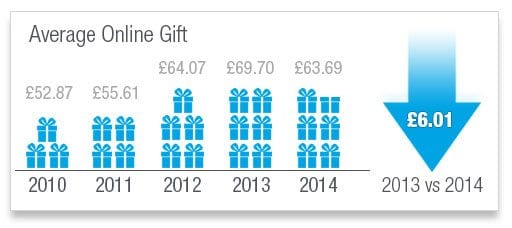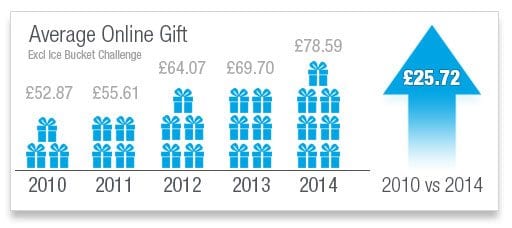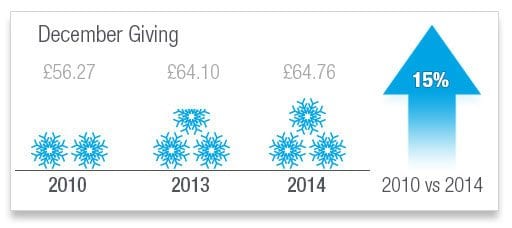Ice Bucket Challenge success drives down average online gift in UK for 2014
The average online gift to UK charities in 2014 was £63.69, according to Blackbaud’s Online Giving Index. Unusually, this represents a 8.6% decrease on the previous year, the first time this figure has fallen in five years.
The reason? The impact of the remarkably successful Ice Bucket Challenge, which raised over $100m for ALS in the UK, plus millions for MNDA and other charities in the UK in August and September 2014.

Average online gifts to charities 2010-2014 – Blackbaud Europe
Average online gift up by 49% in five years – if you exclude Ice Bucket Challenge
If you exclude donations to that campaign then the overage online gift for 2014 was £78.59, an increase of 13% (£69.70) on 2013 and 49% from 2010’s average of £52.87.
The figures are based on analysis by software and services firm Blackbaud on its customers’ online fundraising pages over the five years between 2010 and 2014.

Average online gift to UK charities excluding Ice Bucket Challenge.
Jerome Moisan, Blackbaud Europe’s Managing Director, commented:
“These figures illustrate once again how profoundly successful the Ice Bucket Challenge was to have such an effect on the annual figures, as well as showing that for the fifth consecutive year, average online donation amounts are overall still rising.
“It underlines the importance for all not-for-profits to ensure they are set up to take online donations, both to take advantage of the continuing growth in online giving and to ensure they are ready to capitalise on any future viral campaigns that may cause overnight interest in their cause.”Advertisement
The fundraising team at Motor Neurone Disease Association (MND Association), which was the main UK beneficiary of the viral campaign, were not surprised at the impact of the campaigns donations on overall figures for UK online giving.
Douglas Graham, Director of Fundraising at the charity, said:
“The Ice Bucket Challenge was a one-off phenomenon and its viral nature meant that the vast majority of income came from a very large number of £5 text donations, but we also saw a huge rise in online donations.
“Compared to 161,000 total donations in the previous year, the Ice Bucket Challenge resulted in 927,000 donations in three weeks!
“Obviously we were very keen to say thank you and engage with these new donors, but getting so much additional data onto the system using our existing processes became our biggest bottleneck in developing a communication programme. So our advice to other charities would be to look at your systems to see if you have the infrastructure and processes in place to handle sudden very large volumes of incoming donations and queries.
“Obviously it is a difficult decision on whether to spend money upgrading to cope with a social media campaign that may never happen, but you can understand what you would do to cope with such a nice problem”.
December remains the most popular month for online giving, according to Blackbaud’s analysis.

December is the most popular month for online giving, according to Blackbaud.
More evidence of rise in social media-driven donations
Blackbaud’s State of the Not-For-Profit Industry (SONI) Survey, conducted in the summer of 2014, also indicated the rise in donations received via social media campaigns. 69% of respondents reported they had received donations from peer-to-peer fundraising, an increase from 60% in 2013 and 38% in 2012.
Organisations that now use some form of social media to communicate with their supporters, has increased from 80% in 2013 to 96% in 2014.
[message_box title=”About the data” color=”blue”] The data was collated and analysed across a sample of 295 UK based not-for-profit organisations which includes charities, arts & culture and educational organisations, of varying sizes. This year’s data comes from a larger pool of not-for-profit organisations than in previous years.
For example, the inclusion of educational organisations meant the average amount was higher than other studies have shown, as people donate significantly more within that sector. The sample set of organisations fundraise through their own proprietary websites. Reported information may vary subject to new organisations that join or drop out of the control sample.[/message_box]



